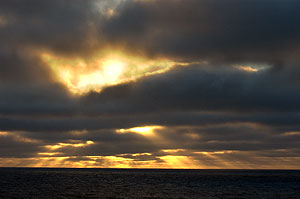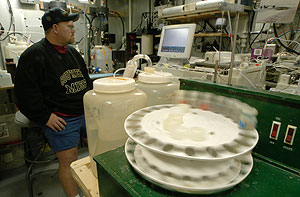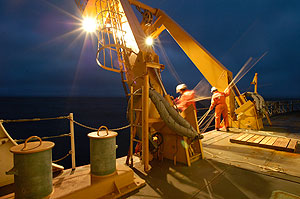|
|
 |
 |
 |
| Crepuscular rays, also known as "godbeams" shine down through the clouds. |
Click to enlarge
|
Daily Update
Calendar
Dispatch 25 - September 25, 2004
By C. A. Linder
Weather conditions: Partly cloudy skies, 20 kt winds, 4-6 ft
seas, air temperature 31°F
Sunny Skies and CTDs
The Marine Science Technicians' forecast from yesterday was right
on. The storm vented the rest of its fury through the night, but was
spent by dawn. By the time I finished breakfast, the CTD was already
back in the water taking measurements of our arctic eddy. Broken
clouds scudded across the sky, and the sun peeked out from the
behind the clouds throughout the day.
Last night we completed an extremely high resolution XCTD survey of the eddy. I asked Bob Pickart to share his thoughts on this accomplishment.
"During the previous SBI cruises we've crossed through a large number
of eddies as we've carried out our predetermined track lines. The
fact that we've seen so many of them suggests that the eddies play
an important role in carrying water from the shelf to the basin. However,
our serendipitous views up to this point have given us only limited
information on their characteristics and how they actually accomplish
this offshore transport. Hence one of the goals of our final cruise
this year was to find such a feature and sample it in detail. This
is easier said than done, however. It involves patience as well as
some luck, and it was by no means clear that we could accomplish our
objective.
After our "large scale" search the other night we found only one area
that showed any promise of eddy activity. We were somewhat disappointed,
but since this was our only lead we had no choice but to take our
one shot and commence a detailed "search pattern". Much to our delight,
our XCTD survey soon revealed the presence of a strong cold core eddy,
just the type of feature we were hoping to find! It was extremely
impressive that the Healy could carry out this survey through such
rough seas and nasty conditions---the Marine Science Technicians deserve
much credit for working so diligently throughout the night. By early
morning the grid was complete and we
had obtained a detailed three-dimensional view of a newly-spawned
western Arctic eddy. Tonight we are taking one
last cut through the eddy, collecting valuable chemical and biological
information on these features. Among other things this will help us
figure out how old this particular eddy is, and how large numbers
of such eddies together might impact the Arctic food chain."
 |
 |
| Erik Quiroz runs a batch of standards on the nutrient auto-analyzer. |
Click to enlarge
|
 |  |
| Marine Science Technicians Ian Fallon and Eric Rocklage retrieve the CTD. |
Click to enlarge
|
One of the important chemicals we measure in our water samples
is the quantity of dissolved nutrients. Nutrients--silicate, phosphate,
nitrite, and nitrate--can be thought of as the fertilizer that nourishes
tiny marine plants called phytoplankton. With nutrients and sunlight,
phytoplankton grow, and in turn form the base of the Arctic food web.
Erik Quiroz is analyzing the nutrient content
of our water samples on this cruise. I ran into Erik today while he
was running the nutrient Auto-Analyzer machine in the lab.
This is quite a complicated piece of machinery. How
does it work?
Erik: "It's definitely complicated, so let's start
at the beginning. We have collected samples of water from different
locations and depths. Each tiny sample has different concentrations
of dissolved nutrients like silicate, etc. The challenge is finding
out how much of each nutrient is present in each sample. That's where
the Auto-Analyzer comes in. It extracts a bit of the water sample
for each nutrient and then adds chemical reagents. The ensuing chemical
reaction produces a color. The machine then measures how much of this
color is produced, and using a known relation and an equation, we
can compute how much of that particular nutrient is present in the
sample."
What else can you share about the auto-analyzer?
Erik: "Although most of the harware for this machine, the Auto-Analyzer Technicon II, was designed in the 1970s, it has been substantially modified to withstand the rigors of at-sea work and the software is being continuously updated. Only a handful of people in the United States use this machine for marine chemistry... maybe 20 or so. Of those, only half run samples at sea. On short cruises, samples can be preserved in bottles and run back at the lab. On a cruise of this duration, we don't have that luxury. The samples must be analyzed quickly because we only have so many sample bottles. One other benefit to running the chemistry out here on the Healy is that we can see the data immediately and share this information with all of the other scientists. Having that information at hand is really valuable. The scientists on this cruise are interested in nutrients because it helps them better understand how Pacific water (which has a high nutrient content) travels across the shallow Chukchi Sea and into the central Arctic Ocean."
By tomorrow, our detailed section through the heart of the eddy will be complete, and our bow will be pointed southward. Destination: the Chukchi Sea central channel... Mission: recover the last mooring.

|
Traducido al Español por
David
|
Cielos soleados y CTDs
La prediccion de ayer de los Tecnicos de la tripulacion fue correcta. La tormenta desato toda su furia durante la noche, pero desaparecio al amanecer. Al tiempo que termine de desayunar, la CTD ya estaba en el agua midiendo nuestro eddy artico. Nubes rotas atravesaban el cielo, y el Sol entraba desde detras de las nubes para meternos en el dia.
Ayer por la noche completamos una profunda investigacion con XCTD del eddy. Pedi a Bob Pickart que compartiera sus pensamientos y conclusiones.
“Durante campañas anteriores del SBI, atravesamos un gran numero de eddies con lo que pudimos desarrollar nuestras predeterminaciones. El hecho es que habiamos visto bastantes de ellos y esto nos sugirio que los eddies juegan un importante papel llevando agua del la plataforma a la cuenca. Sin embargo, esta vision superficial nos dio solamente informacion limitada sobre las caracteristicas y como realmente llevan a cabo el transporte mar adentro. Ya que una de nuestras principales metas de la campaña de este año encontrar esta estructura y muestrearlo en detalle. Esto es mas facil decirlo que hacerlo. Esto requiere paciencia y suerte, y no estaba nada seguro que cumplieramos nuestro objetivo.
Despues de buscar superficialmente la otra noche, solo encontramos
un area que reflejaba algo de actividad de eddy. Estabamos de alguna
manera decepcionados, pero ya que esta era la unica oportunidad que
teniamos no teniamos otra que comenzar a buscar en detalle. Para nuestra
tranquilidad, nuestro XCTD nos revelo pronto la presencia del fuerte
y frio centro del eddy , justo el tipo de figura que habiamos estado
esperando encontrar! Era impresionante que el Healy pudiera
llevar a cabo este reconocimiento a traves de este mar picado y penosas
condiciones. Los tecnicos marinos de la tripulacion merecen nuestra
admiracion por su buen trabajo realizado durante toda la noche. Por
la madrugada la mallas estaba completada
y obtuvimos una detallada vision tridimensional de un nuevo eddy expandiendose
en el oeste Artico. Esta noche estamos llevando a cabo el
ultimo transecto a traves del eddy, recogiendo valiosa informacion
quimica y biologica de esta figura.
Sobre todo esto nos va a ayudar a hacernos una idea de lo antiguo
que es este eddy en particular, y como gran numero de estos eddies
juntos impactan en la cadena alimenticia del artico”.
Uno de los parametros quimicos mas importantes que medimos en nuestras muestras es la cantidad de nutrientes disueltos que hay en el agua. Los nutrientes, incluyendo silicato, fosfato, nitrito y nitrato se podrian llamar fertilizantes de larvas de esas pequeñas plantas llamadas fitoplancton. Con estos nutrientes y la luz solar, el fitoplancton crece y entra a formar parte de la alimentacion del resto de la cadena alimenticia. Erik Quiroz esta analizando el contenido de nutrientes en nuestras muestras de agua en esta campaña, y estuve con el hoy mientras ponia en funcionamiento la maquina autoanalizadora de nutrientes en el laboratorio.
Esta es una maquina bastante complicada, Nos la puedes explicar?
Erik: “ Si que es complicada, asi que empezaremos
por el principio. Tenemos algunas muestras de agua de diferentes partes
del oceano Artico. Cada una de ellas tiene distintas concentraciones
de nutrientes disueltos como silicato, ..Se trata de encontrar en
cuanta proporcion se encuentra cada nutriente en cada muestra. Esto
es lo que viene a hacer el Autoanalizador. Extrae un poco de agua
de la muestra para cada nutriente y entonces añade agentes quimicos.
La mezcla quimica produce una coloracion. La maquina entonces mide
cuanto de este color se ha formado, y usando una ecuacion conocida,
podemos averiguar cuanta cantidad de un nutriente en particular esta
presente en la muestra.”
Que mas puedes compartir con nosotros del Autoanalizador?
Erik: “ Esta maquina en particular, el Autoanalizador
Technicon II, fue diseñado en los años 1970. Solo unas pocas personas
en los Estados Unidos utilizan esta maquina para quimica marina…puede
que 20 mas o menos. De estas, solo la mitad lo llevan a cabo en el
mar. En pequeñas campañas, las muestras pueden ser preservadas en
botellas y llevadas al laboratorio. En una campaña de esta duracion
no tenemos ese privilegio, las muestras deben ser analizadas rapidamente
por que no tenemos tantas botellas. Otro de los beneficios que tiene
analizar aqui en el Healy es que podemos ver los datos inmediatamente
y compartirlos con los otros cientificos. Tener esta informacion a
mano es muy util.”
 Previous
Dispatch
Next Dispatch Previous
Dispatch
Next Dispatch

Back to Calendar
|
|




